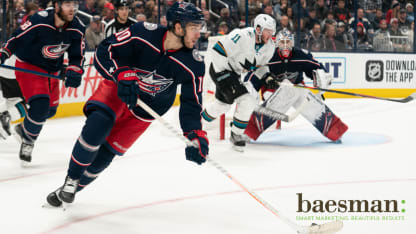Number: 10
Age: 26
Birth date: Sept. 22, 1994
Birthplace:Stockholm, Sweden
Height, weight: 6-2, 197
Stats: 57 GP, 5-17-22, 1.2 point shares, 50.99 xGF% at 5-on-5 per Natural Stat Trick
Contract:Signed through 2022-23 season (three years remaining)
It seems hard to believe, but Wennberg just turned 26 years old.
He recently completed his sixth full season with the Blue Jackets and has played 415 career regular-season games; by the end of next season, he could be in the franchise's top 10 for games played, and after Boone Jenner, he's the closest Blue Jacket to joining the team's eight-member 500 games club.
In many ways, his veteran nature belies just how young Wennberg still is. He debuted at age 20 in 2014-15 and has played at least 57 games in each of the intervening six years, making him one of the most consistent players on the squad when it comes to being ready to play each night.
Of course, it's what has happened when Wennberg does hit the ice that has become a place of consternation at times for CBJ fans and even the coaching staff and front office. By now, the story is well known -- after a 59-point season in 2016-17 (0.74 points per game), Wennberg has followed up with seasons of 35 (0.53 per game), 25 (0.33 per game) and 22 points (0.39).
The edict from head coach John Tortorella is that Wennberg needs to hold the puck more and make more plays with his fantastic vision, and the player himself has expressed frustration as to his inability how to figure out more offensively.
It seems as though it will forever be the battle for Wennberg, whose defensive and penalty kill abilities have never been questioned. After a season both Wennberg and his coach saw as an improvement, especially when it came to Wennberg's playoff performance, Tortorella admitted the ups and downs for the center continue to be frustrating.
"It (ticks) me off and it excites you at the same time," Tortorella says of the inconsistencies. "Wenny wants to try to get better. He wants to see how he can improve. ... I thought (in the playoffs) he just started carrying the puck, carrying the puck to the middle of the ice, held on to pucks, won some faceoffs. I think I played him 23 minutes in (Game 5 vs. Tampa Bay) and he deserved it.
"But it (ticks) me off why he isn't there all the time."
Entering the season: Wennberg was expected to again fill a spot as one of the team's four centers while playing penalty kill time. Anything else was going to have to be earned by him after a two-goal season in 2018-19 that ended in frustration as he was a healthy scratch for six of 10 postseason games.
Season recap:Things were better for Wennberg, who needed just nine games to reach his goal total from the year before. He ended up with five goals and 22 points, modest improvements in goals and points per game despite playing in just 57 games after missing nearly a month during February because of injury.
They weren't the kind of numbers that would knock your socks off -- he was on a 7-25-32 pace for an 82-game season -- but they were better, and there were times throughout the season where Wennberg appeared more driven to play with the puck on his stick and more willing to impose himself on the game. After posting just 64 shots on goal in 75 games in 2018-19, Wennberg had 72 in 57 games this past season.
Perhaps the biggest reason for his drop in overall production over the past few years, though, has come on the power play. While Wennberg accounted for 1.35 points per 60 minutes at 5-on-5 in 2019-20, down from 1.57 points per 60 three years ago, it's not a precipitous drop.
But whereas Wennberg had 6.51 points per 60 minutes on the power play three years ago, he played half the amount of power-play time this season and was at 2.56 points per 60 when he was on the ice. Where both Wennberg and the team's power play excellent during the 50-win season of 2016-17, neither has been able to recapture the magic since then.
Wennberg also played key penalty kill time, mostly with his favorite powerkill partner Cam Atkinson but also with others thanks to the injuries Atkinson suffered, and again was a solid member of a unit that was one of the best in the NHL yet again.

